Standing out as a local business in 2024? It can be a formidable task. Take, for instance, a law firm in Florida – amidst the competitive hustle of cities like Miami or Orlando, how does it ensure that local clients find it first? This scenario isn’t unique to law firms; it’s a reality faced by all local small businesses, from restaurants, retail stores to any local professional service firms.
This guide breaks down local search engine optimization (SEO), a cost effective marketing strategy that can help you rise above your competition. Whether you’re a seasoned business owner or new to online marketing, you’ll discover practical, actionable strategies here.
We’ll show you how to enhance your online presence, attract more local customers, and grow your business in a way that resonates with your community, no matter your industry.
Quick summary
✅ Understand Local SEO: Grasp what local SEO is and why it’s vital small businesses to thrive in today’s market.
✅ Real Benefits: Learn the tangible benefits of local SEO, such as increased visibility search engine results pages, attracting more local customers, and building a strong, reputable presence in your community.
✅ Practical Strategies: Uncover actionable local SEO strategies that are effective across various industries, helping you to optimize your online presence and become more visible to your local audience.
✅ Real Results: See real-life success stories, like how Dynamic Solutions Group and Data Cube Systems dramatically improved their local search presence and business leads through targeted local SEO strategies. These case studies provide concrete examples of local SEO’s power to transform business outcomes.
Understanding Local SEO
What is Local SEO
Local SEO is the process of optimizing your business’s online presence to attract more customers from relevant local searches. These searches take place on Google and other search engines, often with geographical qualifiers, like “dentist in Tampa” or “roofing company near me.”
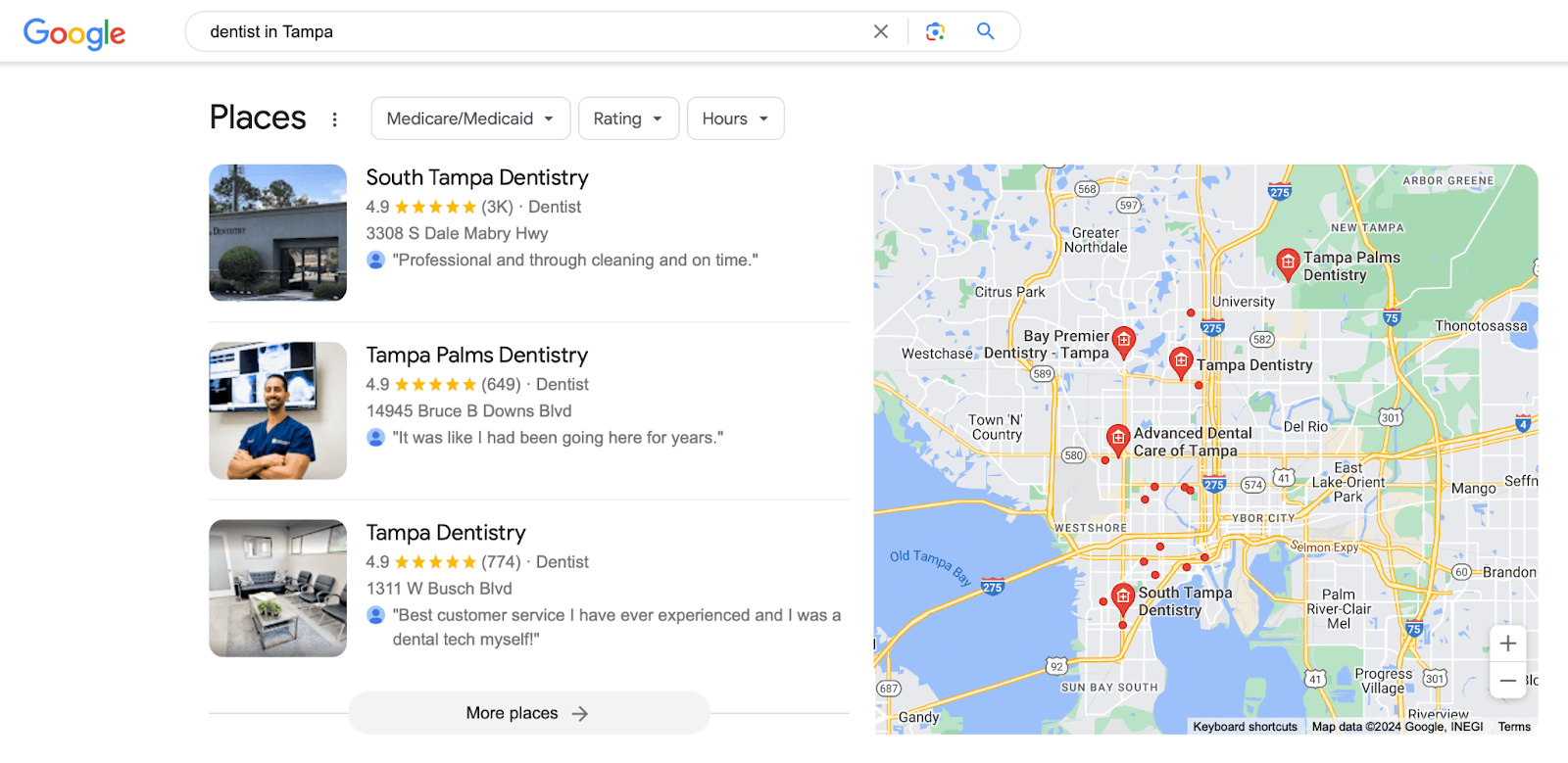
For instance, when a financial firm in Jacksonville optimizes for local SEO, it increases its chances of appearing at the top of search results when nearby clients search for financial advice – making it a critical strategy for businesses that serve specific localities.
Difference Between Local and National SEO
Understanding the difference between local and national SEO is key to tailoring your digital marketing strategy effectively. While both aim to increase your online visibility, they target different audiences and have distinct outcomes.
National SEO
Audience Targeting: National SEO is broader in scope, aiming to reach a national or even global audience. It’s ideal for businesses that operate online without a specific geographical focus.
Strategies: This involves optimizing your website for a wide range of keywords, focusing on industry-specific terms without geographical qualifiers. For example, a software provider might target keywords like “efficient project management tools” to attract a global audience.
Outcomes: The goal is to drive traffic from a diverse set of locations, which can be beneficial for brand recognition and online sales on a larger scale.
Local SEO
Audience Targeting: Local SEO specifically targets an audience within a certain geographical area. It’s crucial for businesses like dental clinics or roofing companies that serve specific localities.
Strategies: This includes optimizing for local keywords (e.g., “dentist in Gainesville” or “roof repair in Albany”), managing local listings like Google My Business, and ensuring NAP (Name, Address, Phone Number) consistency across online directories. Local content creation, like blogs about community history (an article about the history of dentistry in Gainesville for example), also plays a significant role.
Outcomes: The primary aim is to appear in local search results and Google Maps, making your business more visible to the local community. This leads to increased foot traffic, local brand recognition, and higher conversion rates as the traffic is more targeted.
By understanding these differences, businesses can better allocate their SEO efforts.
For example, a law firm with multiple locations across Florida might combine both strategies – using national SEO to build its brand and authority in the legal field, while implementing local SEO tactics for each office to attract clients in specific cities.
Why Local SEO is Essential for Small Businesses
But local SEO is not just a tactic – it’s a vital component of your digital marketing strategy. For small businesses, like a law firm in Miami or an MSP company in Orlando, local SEO ensures that they are found by the right people at the right time.
It’s about being visible in your community when potential clients are actively seeking your services. This targeted visibility leads to higher quality traffic, more foot traffic for brick-and-mortar locations, and ultimately, more business.
Benefits of Local SEO
OK, you get that local SEO is a powerful tool that can significantly transform your business, but let’s take a deeper look at the benefits. Here are the key advantages:
Increased Local Visibility
Local SEO puts your business on the map, quite literally. 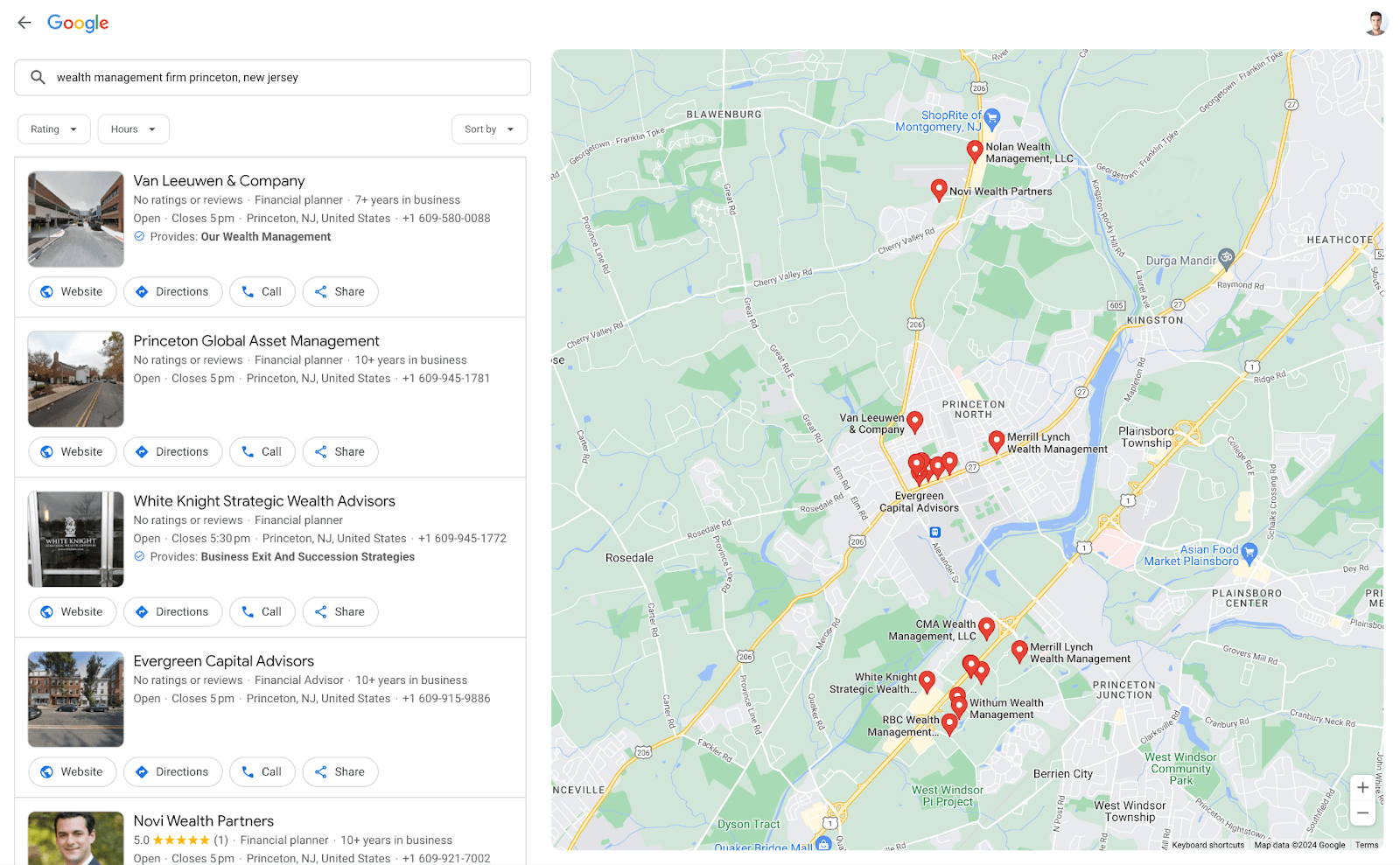
By optimizing for local search, businesses like a wealth management firm Princeton, New Jersey can appear prominently in local search results and on Google Maps.
This increased visibility means that when locals or visitors in the area search for services or products you offer, your business stands out. It’s about being the first option they see and consider.
Attracting Local Customers
One of the most significant benefits of local SEO is its ability to attract customers who are ready to act. For instance, a person searching for “emergency pest control in Tallahassee” is likely in immediate need. If your pest control business appears at the top of these local search results, you’re not just gaining a visitor to your website; you’re attracting a potential customer who is ready to engage your services right away.
Building Local Reputation
Local SEO also plays a crucial role in reputation building. By managing your online reviews and local citations, you’re not only improving your search rankings but also establishing trust within your community. For example, a well-rated law firm in San Jose with positive reviews on Google and local directories will naturally attract more patients due to the established trust and credibility.

Additionally, local content marketing, like participating in or sponsoring community events and then featuring them on your site, can further enhance your local reputation and connection with the community.
Local SEO Strategies and Implementation
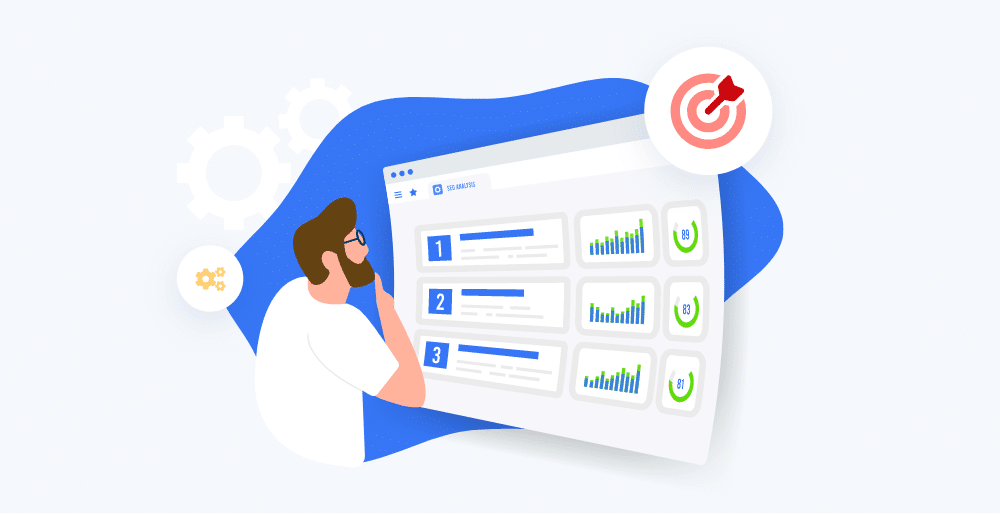
Now, for beginners, local SEO can seem daunting, but it’s about taking the right steps to ensure your business is visible and appealing to your local community online. This section breaks down these strategies into manageable, actionable steps. We’ll guide you through each aspect of local SEO, from keyword research to schema implementation, in a way that’s easy to understand and apply, regardless of your technical expertise.
Keyword Research for Local SEO
Effective keyword research is the cornerstone of any local SEO strategy. It’s about finding the right words and phrases that potential customers in your area use to search for services or products like yours. Let’s walk through this process using a practical example I mentioned earlier: a pest control company in Tallahassee, Florida.
Step 1: Define Your Core Services
Begin by identifying the primary services your pest control company offers in Tallahassee. This might include “residential pest control,” “termite inspections,” and “rodent removal.”
Understanding the specific services you provide is crucial for pinpointing the exact keywords your potential customers in Tallahassee are using to find businesses like yours.
Step 2: Use Ahrefs for Local Keyword Ideas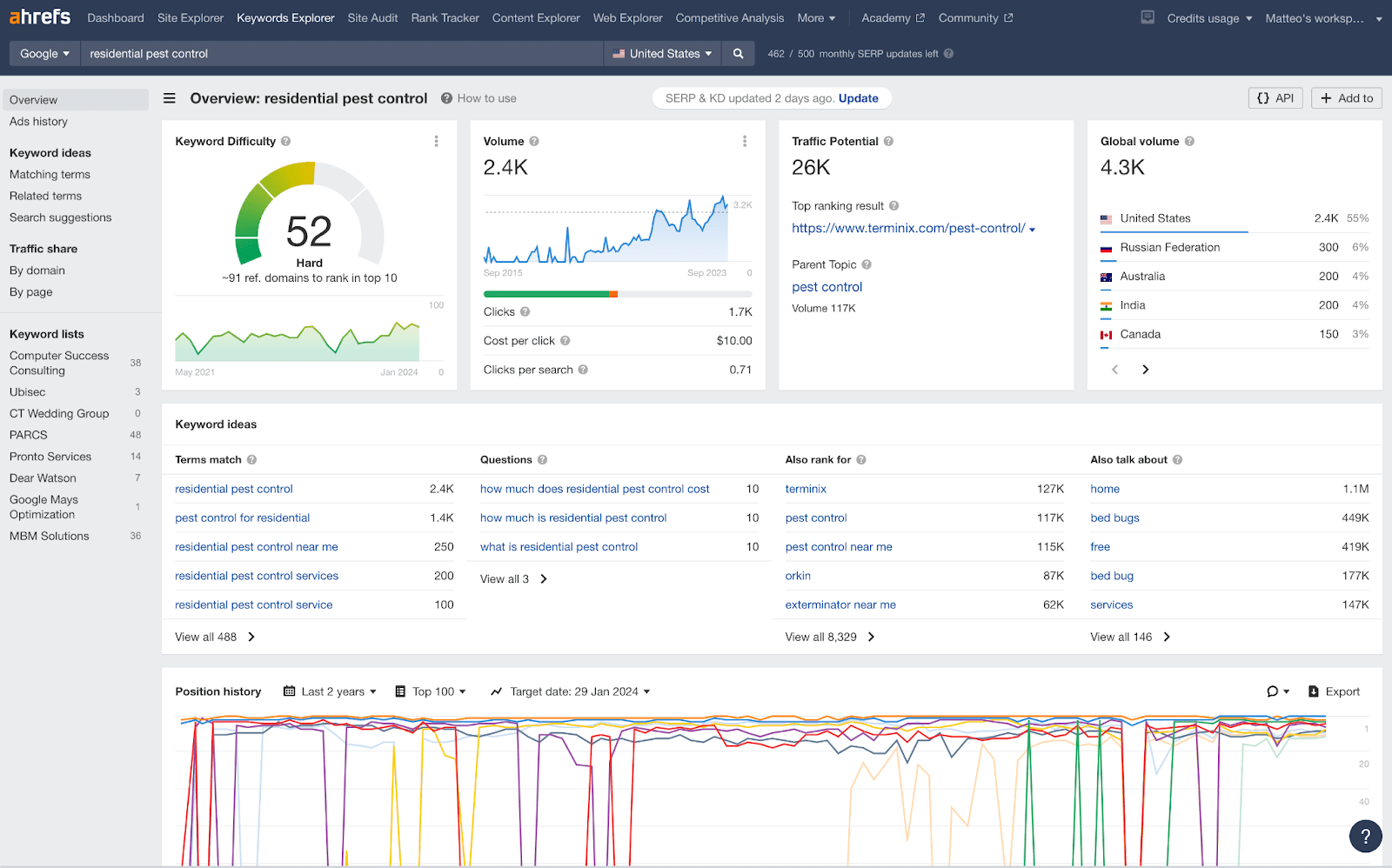
Access Ahrefs Keyword Explorer. Input your core services one at a time, and set the location to your service area. This will tailor the search results to your specific local area.
For instance, the pest control company in Tallahassee might enter “residential pest control” into their keyword research tool. They would then analyze the “keywords”, looking for variations and related terms that people in Tallahassee are searching for, such as “pest control tallahassee fl.”
Step 3: Analyze Keyword Difficulty and Search Volume
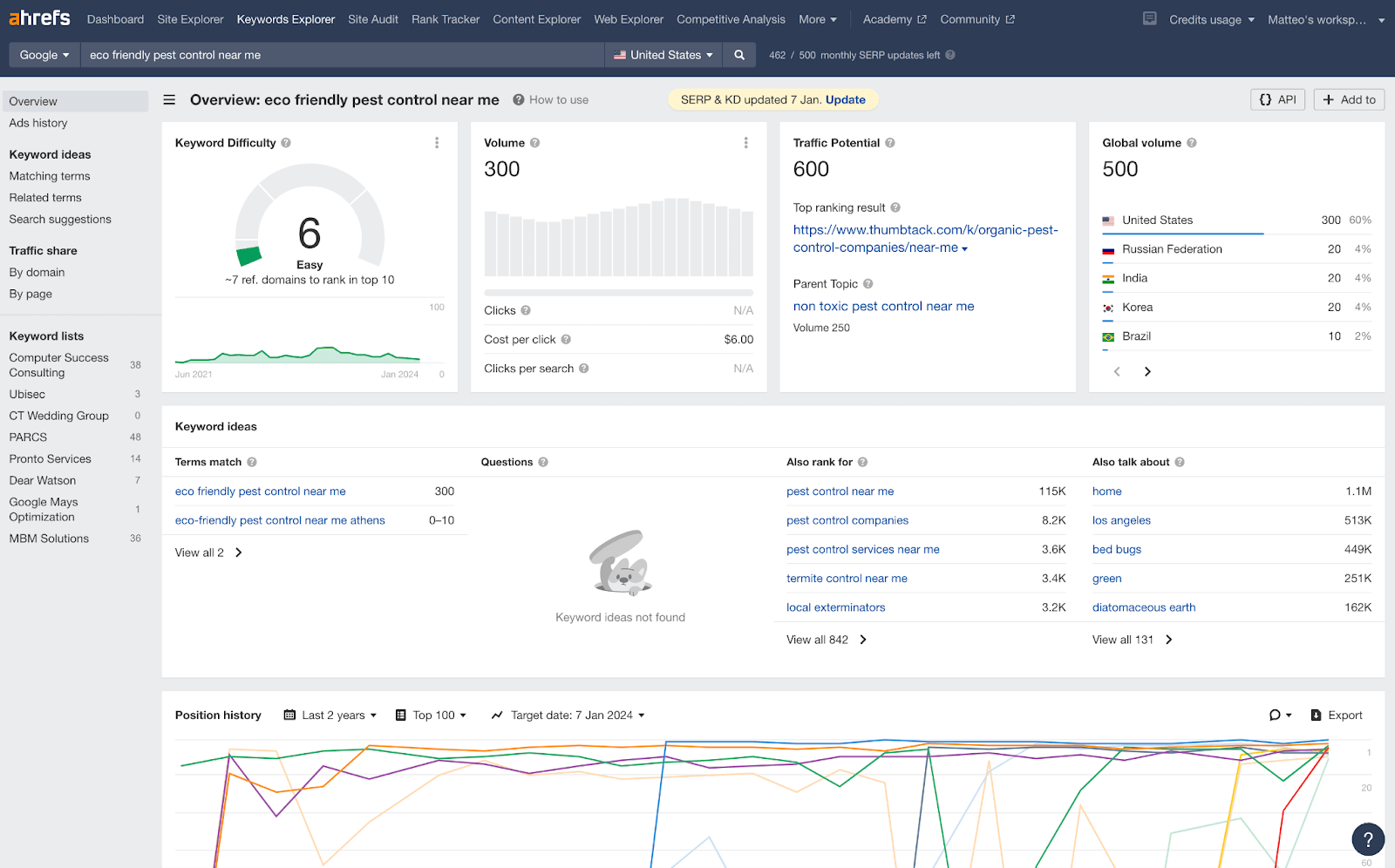
In Ahrefs, assess the Keyword Difficulty (KD) score and search volume for each term. A lower KD score means it’s easier to rank for that keyword.
Prioritize keywords that strike a balance between search volume and competition. For example, “eco-friendly pest control near me” might have fewer searches but also less competition compared to a broader term like “pest control services.” This approach can help your business stand out in a specific niche within your market.
Step 4: Consider Long-Tail Keywords
Long-tail keywords are longer, more specific phrases. They often have lower search volumes but can attract more targeted traffic.
Identify long-tail keywords that are specific to your services and location. For the pest control company in Tallahassee, a relevant long-tail keyword could be “tallahassee termite control.” Such specific phrases are typically less competitive and can attract a more targeted audience looking for precise services in your area.
Step 5: Compile Your Keyword List
Create a list of your chosen keywords, balancing between broader local terms and specific long-tail keywords.
This list will guide the content creation for your website, ensuring you’re targeting the terms your local customers are using.
Step 6: Implement Keywords in Your Website
Use these keywords strategically in your website’s content, meta titles, descriptions, and URLs. For the pest control company in Tallahassee, this involves incorporating terms like “tallahassee pest control” naturally in their website’s homepage, service pages, and blog posts. This strategic placement ensures that the content is relevant both to local customers and search engines.
Optimizing for Google My Business
Optimizing your Google My Business (GMB) listing is a vital step in local SEO, especially for service-based businesses like plumbing, roofing, etc. It enhances your visibility in local searches and Google Maps, making it easier for customers to find and choose your services. Let’s go through this process using another example: a health food store in Oklahoma City.
Step 1: Claim and Verify Your Business
Start by claiming your Google My Business listing. Our health food would search for their business on Google and select “Claim this business” or “Own this business?”
Next, simply complete the verification process, which usually involves Google mailing a verification code to your business address.
Step 2: Fill Out Every Detail in Your Profile
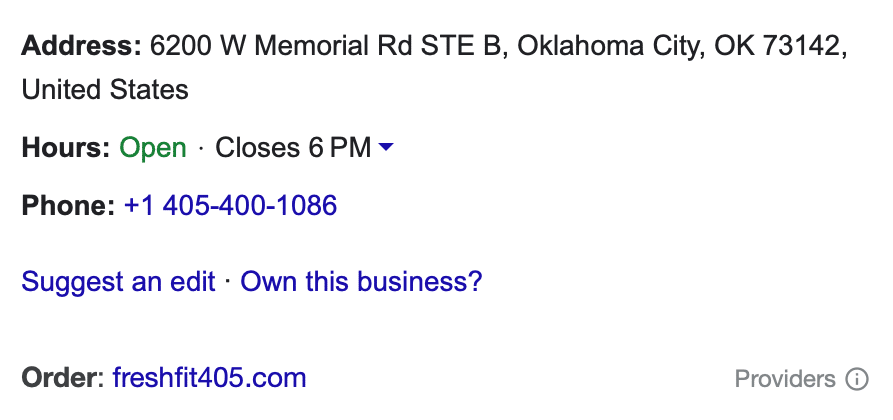
Provide comprehensive information in your GMB profile, including your company’s name, address, phone number, and hours of operation.
Accuracy and consistency are key. Ensure your details match across your website and other online directories.
Lastly, make sure your business profile is properly categorized. In this case, it’s obvious – “Health food store”, but depending on your business, you might have to choose more than one category to paint the full picture.
Step 3: Craft a Compelling Business Description
Write a description that captures what sets your health food menu apart. Highlight specializations. The Oklahoma health food store might put focus on emergency plumbing services, eco-friendly solutions, or years of experience in the Hartford area.
Incorporate the relevant local keywords you found in your keyword research. In our example, it could be “reliable Hartford plumber” or “emergency plumbing services in Hartford.”
Step 4: Add Quality Photos
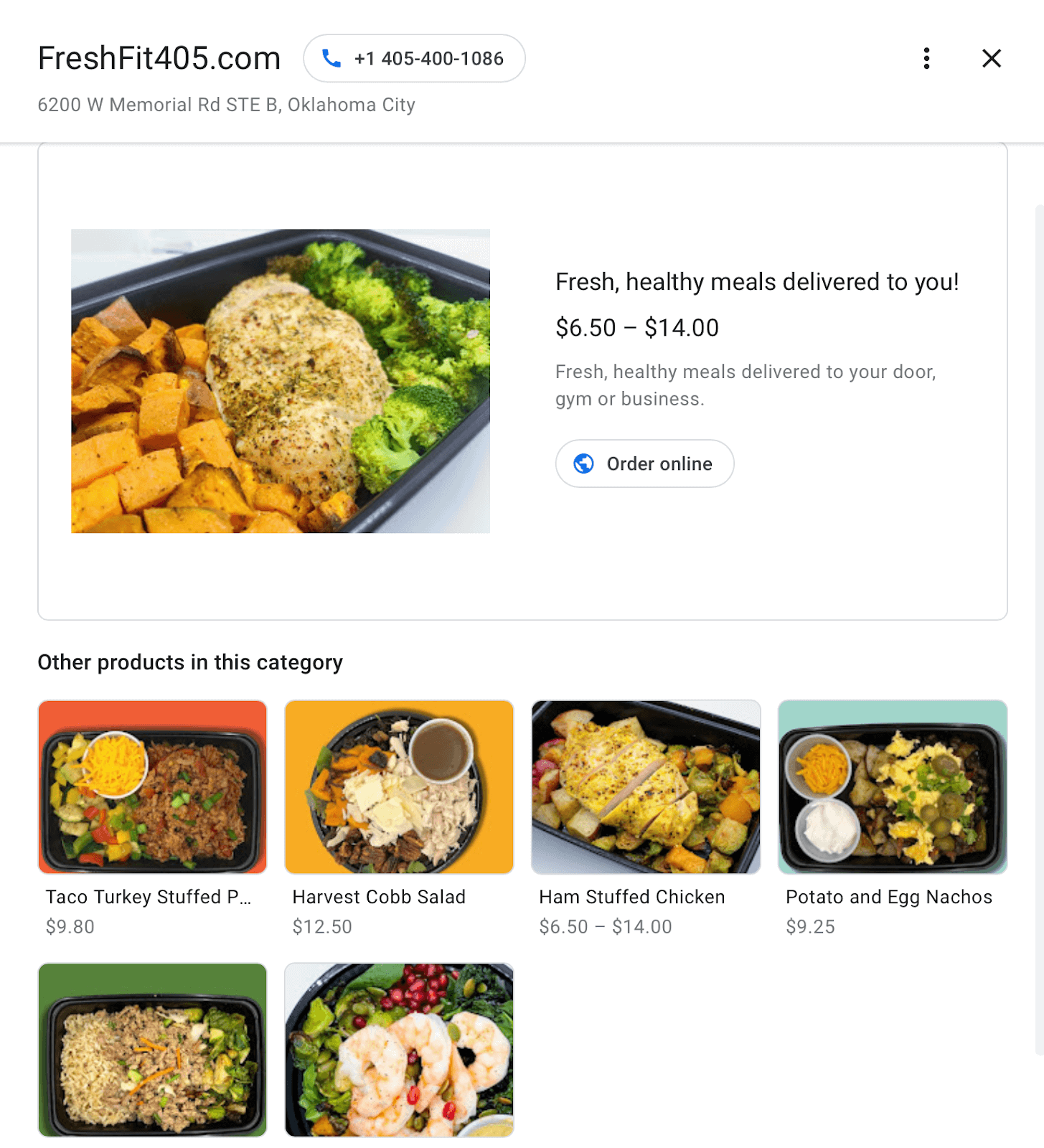
Upload clear, professional photos of your team, products, services, and examples of completed work. In this case, pictures of the
Keep your photo gallery updated to engage potential customers and showcase your latest products.
Step 5: Actively Manage and Respond to Reviews

Encourage satisfied customers to leave reviews on your GMB profile.
Respond to all reviews, thanking customers for positive feedback and addressing any concerns raised in negative reviews. This demonstrates your commitment to customer satisfaction. More on this later…
Step 6: Regularly Post Updates
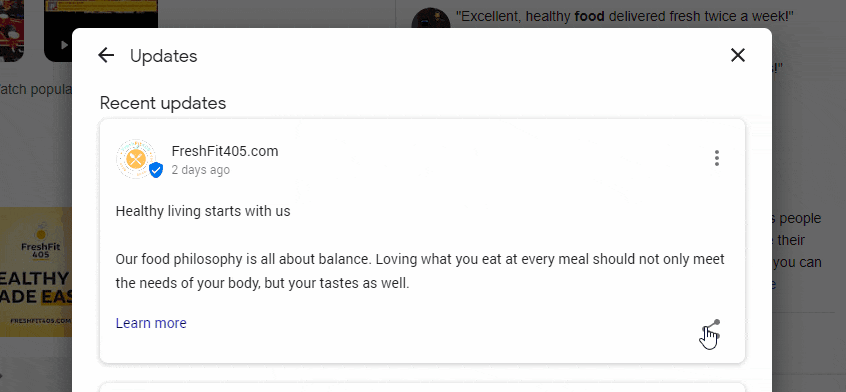
Use GMB Posts to share updates about your services, special offers, or helpful diet tips.
Regular activity on your GMB profile can signal to Google that your business is active, which can help improve your local search ranking.
Step 7: Analyze Your GMB Insights
Regularly review your GMB Insights to understand customer interactions with your listing, such as how they found you and what actions they took.
Use these insights to refine your profile and improve your overall local SEO strategy.
Learn more 👇
GMB Management Service: Looking for quick hand in setting up and optimizing your listing? Our experts can help.
Create Service Location Pages
An effective strategy in local SEO is the creation of service location pages, especially for businesses operating in multiple areas or offering services in specific locations. These pages can significantly boost your local search visibility and drive qualified traffic to your site.
Let’s explore how to create these pages effectively, drawing insights from our detailed guide on the subject.
Why Service Location Pages Matter
Targeted Local SEO: Service location pages allow you to target specific geographic areas, making your site more relevant and visible in local searches for those areas. For example an MSP in New Jersey might be looking to serve the tri-state area at large.
Enhanced User Experience: These pages provide potential customers with location-specific information, improving their experience and increasing the likelihood of engagement.
How to Create Effective Service Location Pages
Identify Your Service Areas
Start by listing the locations where you offer services. This could be different cities, neighborhoods, or regions.
Ensure that you have a legitimate presence or offer services in these areas to maintain credibility.
Create Unique Content for Each Page
Develop unique, high-quality content for each location page. Avoid duplicating content across multiple pages, as this can negatively impact your SEO.
Include location-specific details such as local services offered, customer testimonials from that area, and relevant local information or landmarks.
Incorporate Local Keywords
As discussed in the keyword research section, include local keywords relevant to each service area in your page content, titles, and meta descriptions. This enhances the page’s relevance in local search results for those specific locations.
Optimize for User Experience
Ensure each service location page is easy to navigate, with clear calls-to-action (CTAs) and contact information.
Include maps or directions if applicable, and ensure the page layout is mobile-friendly.
Link to Your Location Pages
Include links to your service location pages from your homepage or main service page. This not only helps users find these pages but also distributes page authority throughout your site.
Consider featuring a location dropdown menu or a dedicated locations section on your homepage.
Monitor and Update Regularly
Regularly review and update your location pages to ensure the information is current and accurate.
Monitor the performance of these pages using analytics tools to understand traffic patterns and user engagement.
Use-Case: CloudCoCo IT Support in Leeds
To illustrate an effective service location page, let’s examine CloudCoCo’s IT Support page for Leeds. This page exemplifies several key elements we’ve discussed:
Targeted Local Content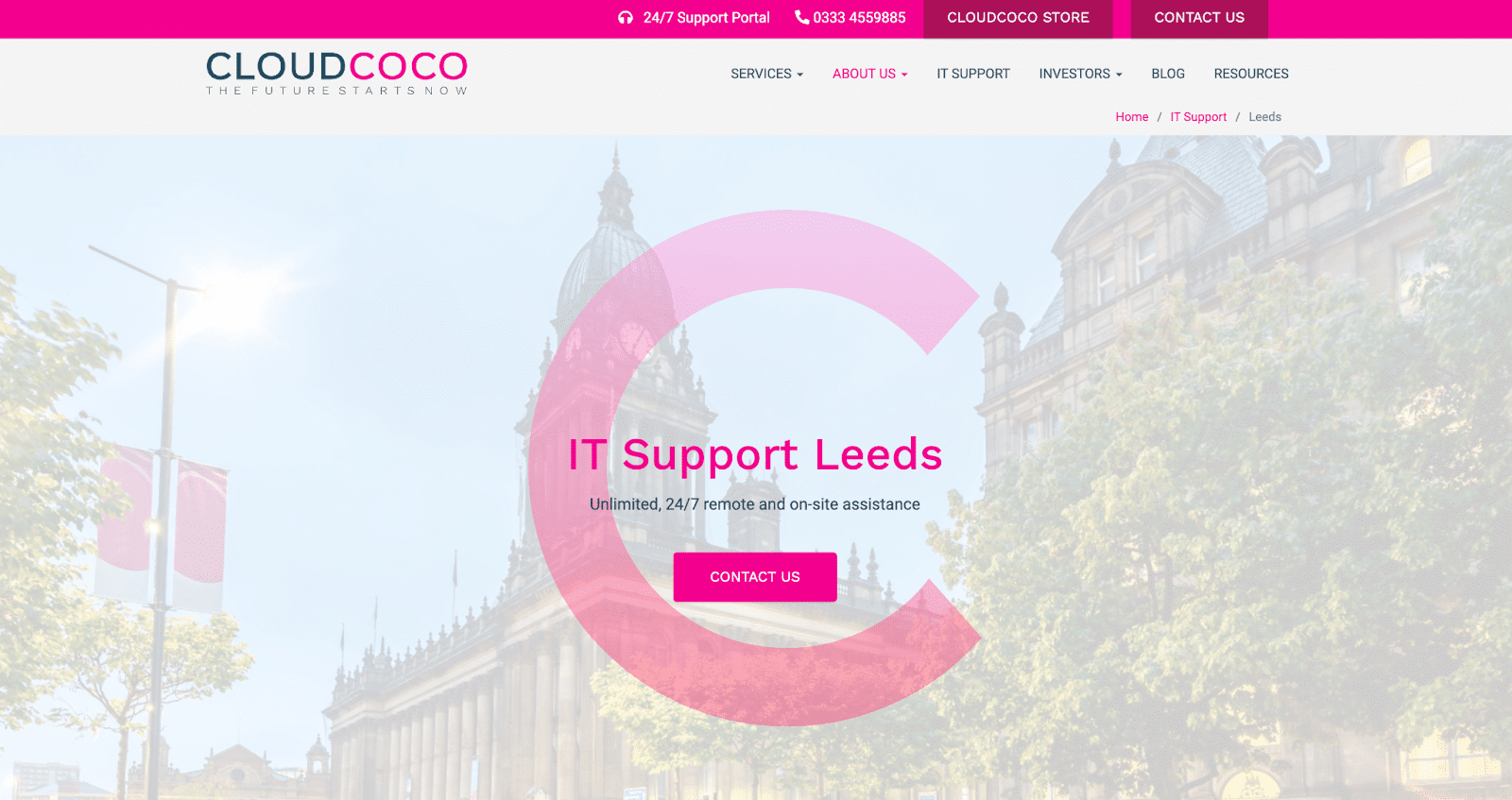
The page begins with a strong, locally-focused introduction, emphasizing IT support services in Leeds. This not only appeals to local businesses but also aligns with local search queries – in this case “it support Leeds”.
Detailed Service Information

It provides internal links to Cloud CoCo’s services, such as managed IT services and cybersecurity, and all other specialties. This specificity helps in matching local search intent.
Local Relevance and Engagement
The page includes insightful information about Leeds, discussing its economic landscape and business environment. This not only boosts local SEO but also engages readers by connecting the services to their city.
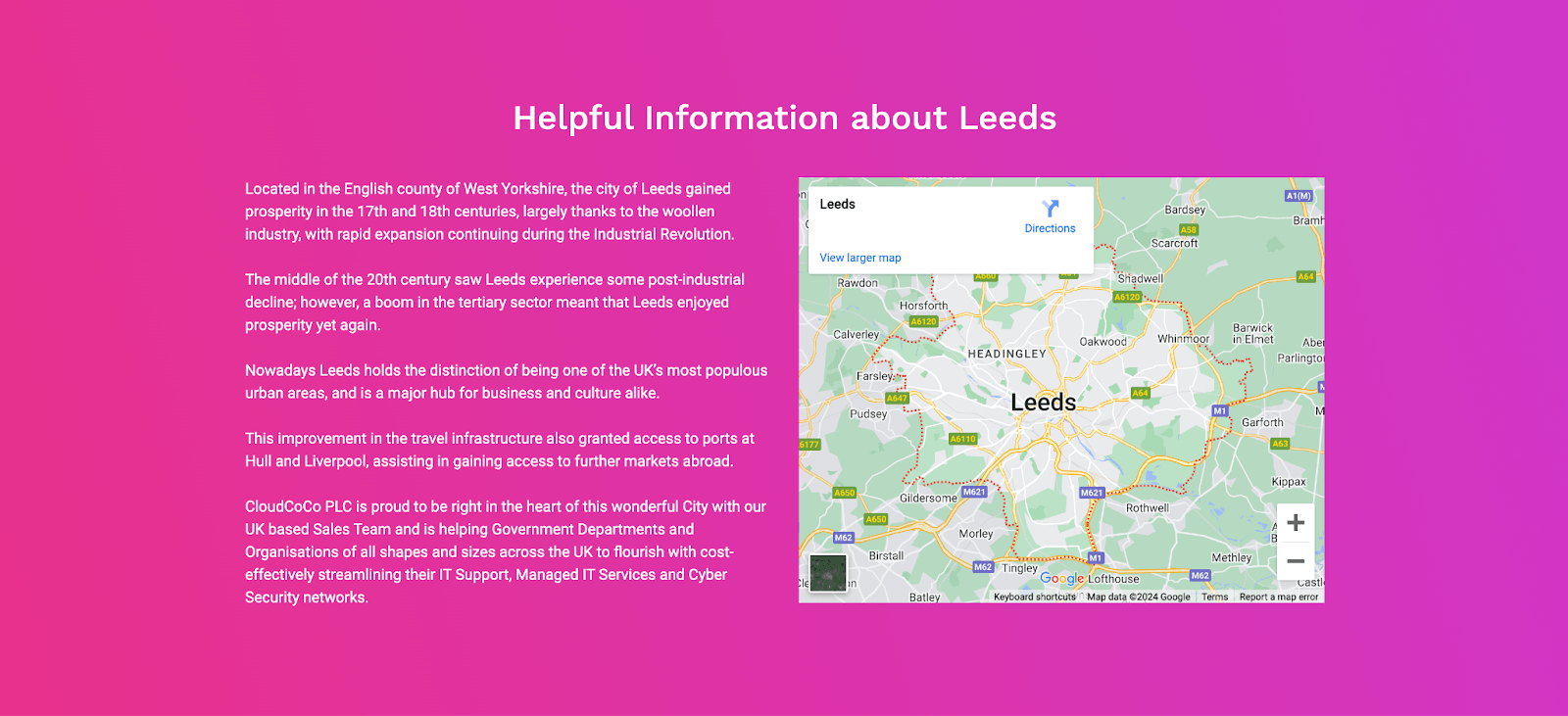
Embedding a Google Map
Embedding a Google Map on the location page, pinpointing the exact location of the business, sends strong local SEO signals. It not only aids in validating the physical presence of the business in Leeds but also enhances user experience by providing a visual and interactive element.
Users can easily view the location, get directions, or explore the surrounding area, which can increase engagement and time spent on the page.
Clear Call-to-Action (CTA)

A prominent CTA is placed, inviting Leeds businesses to contact CloudCoCo for IT support. This direct approach is effective in converting visitors into leads.
Optimized for User Experience

The page layout is clean, mobile-friendly, and easy to navigate, ensuring a positive user experience for visitors accessing it from various devices.
This CloudCoCo location page for Leeds serves as an excellent example of how to craft a service location page that is both SEO-friendly and user-centric.
Learn more 👇
Local Citations and NAP Consistency
For a local business, maintaining consistency in your business’s information across the web is crucial. This practice, known as managing your NAP (Name, Address, and Phone Number) consistency, along with building local citations, significantly boosts your local SEO.
Understanding NAP Consistency
What It Is: NAP consistency refers to the uniformity of your business’s name, address, and phone number across all online platforms – essentially your contact details.
Why It Matters: Search engines like Google value accurate and consistent data. Discrepancies can confuse search engines and potential customers, negatively impacting your local search ranking. And plus, customers don’t want to arrive at a wrong address or call a wrong phone number when looking for services nearby.
Building Local Citations
What They Are: Local citations are mentions of your business on other websites, like local directories, industry-specific directories, and social platforms.
Why They’re Important: Citations increase your online visibility and credibility. They act as signals to search engines, affirming the legitimacy of your business.
How to Manage NAP Consistency and Build Citations
Audit Your Current Online Presence
Start by searching for your company online and note any variations in your NAP across different listings.
Tools like BrightLocal can help automate this process.
Update Inconsistent Listings
Correct any discrepancies in your business information across platforms like Yelp, Yellow Pages, and local business directories.
Ensure that your NAP is identical everywhere – even small differences, like abbreviations, can matter.
Regularly Monitor and Update Your Information
Keep your business information updated, especially if there are changes like a new phone number or a move to a different location in your area.
Regularly check your listings for accuracy and make updates as needed.
Seek New Citation Opportunities
Look for reputable local and industry-specific directories where you can list your local business.
Participating in local events or sponsorships can also lead to natural citations on event websites or local news outlets.
Leverage Social Media and Online Platforms
Ensure your NAP is consistent on all your social media profiles.
Utilize platforms like Facebook and LinkedIn not just for networking but also as additional citation sources.
By diligently managing your NAP consistency and actively building local citations, your plumbing company can enhance its local SEO, making it easier for residents in your service area to find and trust your services.
Managing Online Reviews
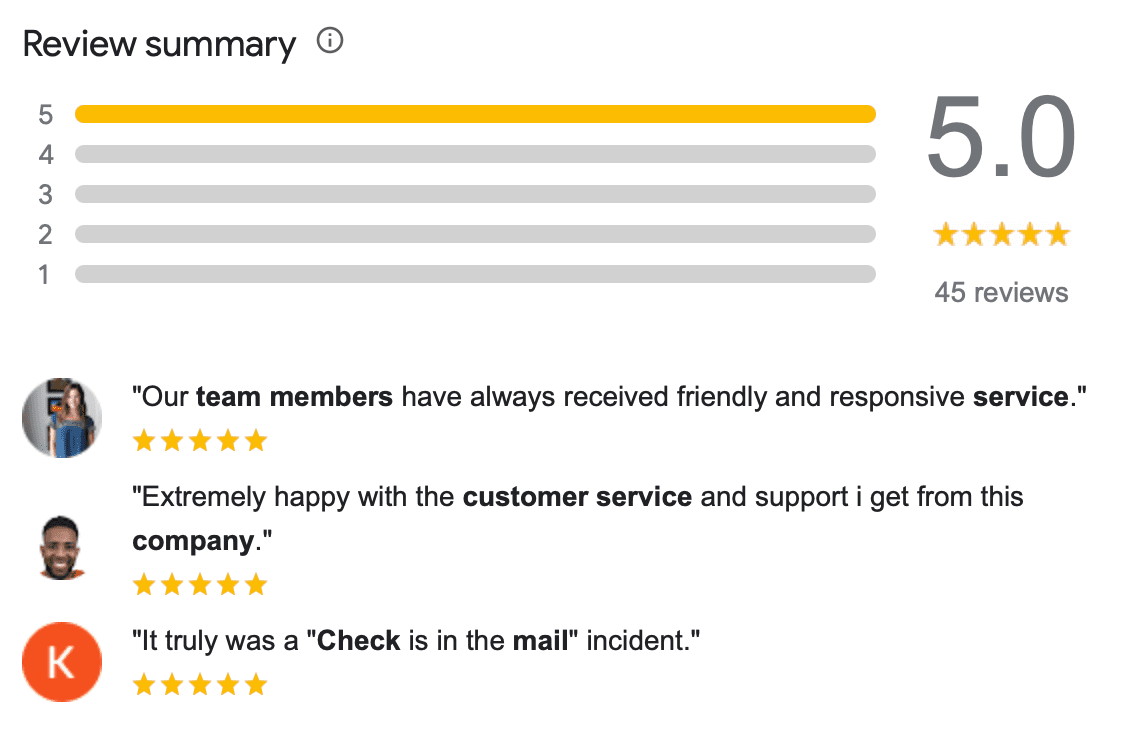
For any local business, online reviews, especially on Google, play a pivotal role in reputation and local SEO. Actively managing and procuring these reviews can significantly impact your business’s success.
Why Google Reviews Matter
Trust and Credibility: Reviews contribute to building trust and credibility with potential customers. Positive reviews can be a deciding factor for someone needing plumbing services.
Local SEO Impact: Google reviews influence your local search ranking. A higher number of positive reviews can improve your visibility in local search results.
How to Manage and Procure Google Reviews
Encourage Reviews from Customers
After completing a service, politely ask your customers to leave a review on Google. Personal requests can be more effective, especially if the customer is satisfied with your work.
Consider sending a follow-up email or text with a link to your Google My Business listing, making it easy for them to leave a review.
Make Reviewing Easy
Provide clear instructions on how to leave a review. You can create a simple guide or include step-by-step instructions in your follow-up communications.
Ensure your Google My Business listing is easily accessible from your website and social media profiles.
Respond to All Reviews
Acknowledge each review by responding promptly. Thank customers for positive reviews and address any negative feedback professionally.
Addressing concerns in negative reviews can demonstrate your commitment to customer satisfaction and can sometimes turn a negative experience into a positive one.
Monitor Your Reviews Regularly
Set up alerts for new reviews so you can respond in a timely manner.
Regularly check your reviews to understand customer feedback and identify areas for improvement in your services.
Leverage Positive Reviews
Showcase positive reviews on your website and social media. This not only celebrates customer satisfaction but also encourages others to leave reviews.
Use positive reviews in your marketing materials as testimonials to attract new customers.
Handle Negative Reviews Constructively
If you receive a negative review, respond calmly and professionally. Offer to resolve the issue offline if necessary.
Use negative feedback as an opportunity to improve your services and customer experience.
Learn more 👇
Local Link Building
Local link building is another vital component of local SEO, yet it’s often one of the least understood. Essentially, it involves acquiring links from other websites to your own, which search engines interpret as a sign of your site’s credibility and relevance.
For local businesses, this means getting local backlinks from sources within your community or industry. Here’s a breakdown of why it’s important and how to effectively engage in local link building, with a special focus on guest posting.
Why Local Link Building is Important
Enhances Local SEO: Links from local sources help search engines recognize your business as a relevant and authoritative entity in your area.
Drives Local Traffic: Being featured on local websites can increase your exposure to a regional audience, potentially driving more traffic to your site.
Strengthens Community Ties: Building links often involves networking with local entities, fostering relationships that can benefit your business beyond SEO.
How to Build Local Links
Identify Local Link Opportunities
Like mentioned earlier, look for local business directories, community websites, or local news sites where you can get listed.
Consider joining local chambers of commerce or business associations that feature member businesses on their sites.
Participate in Community Events
Engage in local events or sponsor community activities. These events often have websites where sponsors are acknowledged with links.
Hosting or participating in local workshops or seminars can also lead to mentions and links from attendees and organizers.
Collaborate with Local Businesses and Influencers
Partner with other businesses for joint promotions or events, leading to mutual linking opportunities.
Engage with local influencers or bloggers for features or collaborations that include links to your site.
Focus on Guest Posting
Identify local blogs, news sites, or industry-specific websites that accept guest posts. These could be platforms related to your business niche or general local interest sites.
Pitch relevant, high-quality content ideas that would interest their audience. For example, if you’re a local retailer, you could write about “Top Trends in [Your Industry] in [Your City].”
Ensure your guest posts include a link back to your website, either in the content or in an author bio. This not only drives traffic but also enhances your site’s authority.
Engage with Local Media
Reach out to local newspapers, magazines, and online news platforms for potential features or interviews.
Share interesting stories or developments about your business that could appeal to a local audience.
Create Content That Appeals to Local Audiences
Develop blog posts, guides, or infographics that are specifically relevant to your local area or community.
Share this content with local websites and social media groups, increasing the likelihood of gaining backlinks.
Monitor and Refine Your Strategy
Use tools like Ahrefs to track the backlinks you acquire and understand their impact.
Regularly assess which link-building strategies are most effective and adjust your approach to maximize results thus your search engine visibility.
Learn more 👇
On-Page SEO for Local Businesses
On-page SEO is crucial for enhancing your local business’s visibility in search engine results. It involves optimizing various elements on your website to make it more attractive to search engines for local online searches. Here’s how to effectively implement on-page SEO:
Optimize Title Tags and Meta Descriptions
Ensure each page on your website has a unique title tag and meta description. Incorporate local keywords relevant to your business. For instance, an plastic surgeon in Atlanta might use a title tag like “Plastic Surgery | [Practice Name] | Atlanta, GA.”
Meta descriptions should be concise and compelling, as they appear in search results and can influence click-through rates. But keep these descriptions between 50-160 characters.
Use Local Keywords Strategically
Recall the keyword research discussed earlier? Integrate those local keywords into your website’s content. This includes using them naturally in your text, headings, and image alt texts.
The goal is to align your content with the terms your local customers are likely to use when searching for your products or services.
Create Locally Relevant Content
Develop content that resonates with your local audience. This could be blog posts about local services, guides relevant to your community, or case studies of local clients.
Regularly updating your site with fresh, locally-focused content can improve your search engine rankings and engage your audience.
Ensure NAP Consistency on Your Website
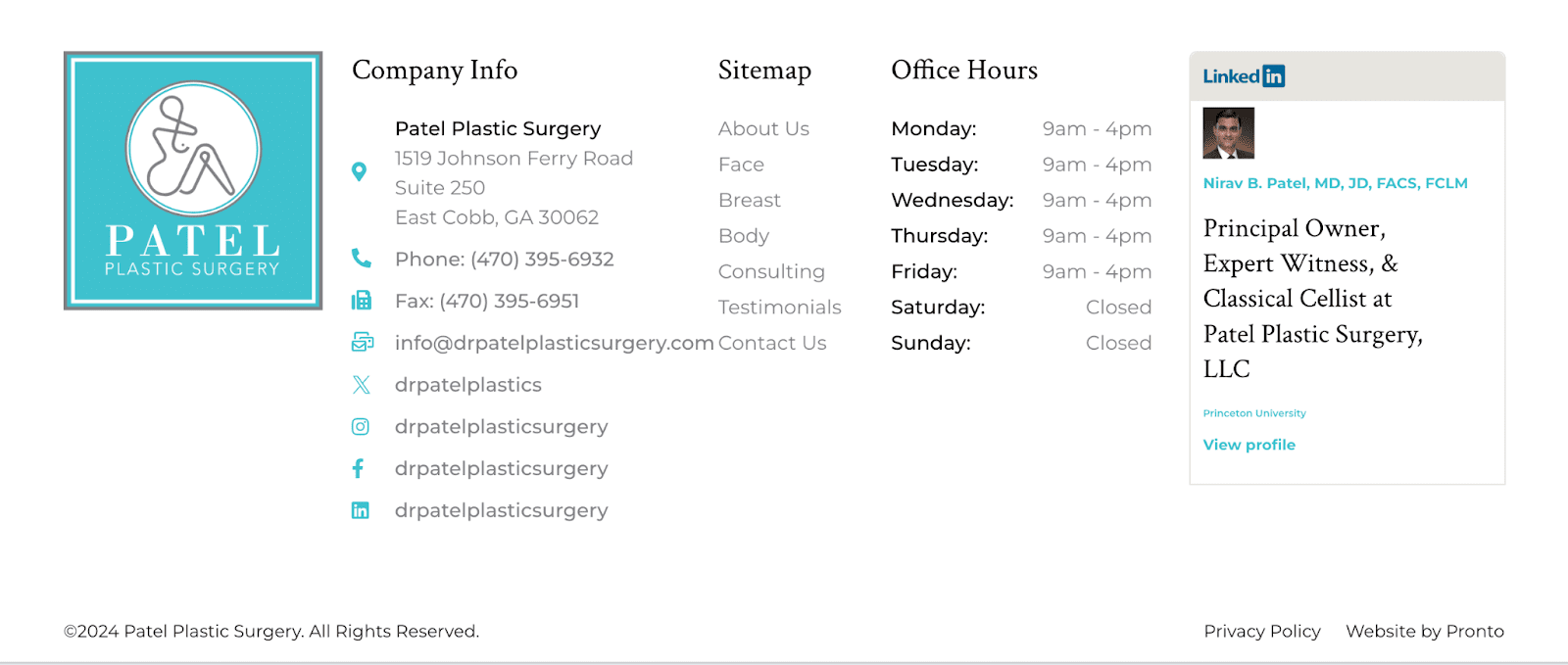
We touched on NAP in directories and listings above, but they should also be consistent across your website.
This information is typically placed in the footer of your website and on a dedicated contact page.
Improve Page Load Speed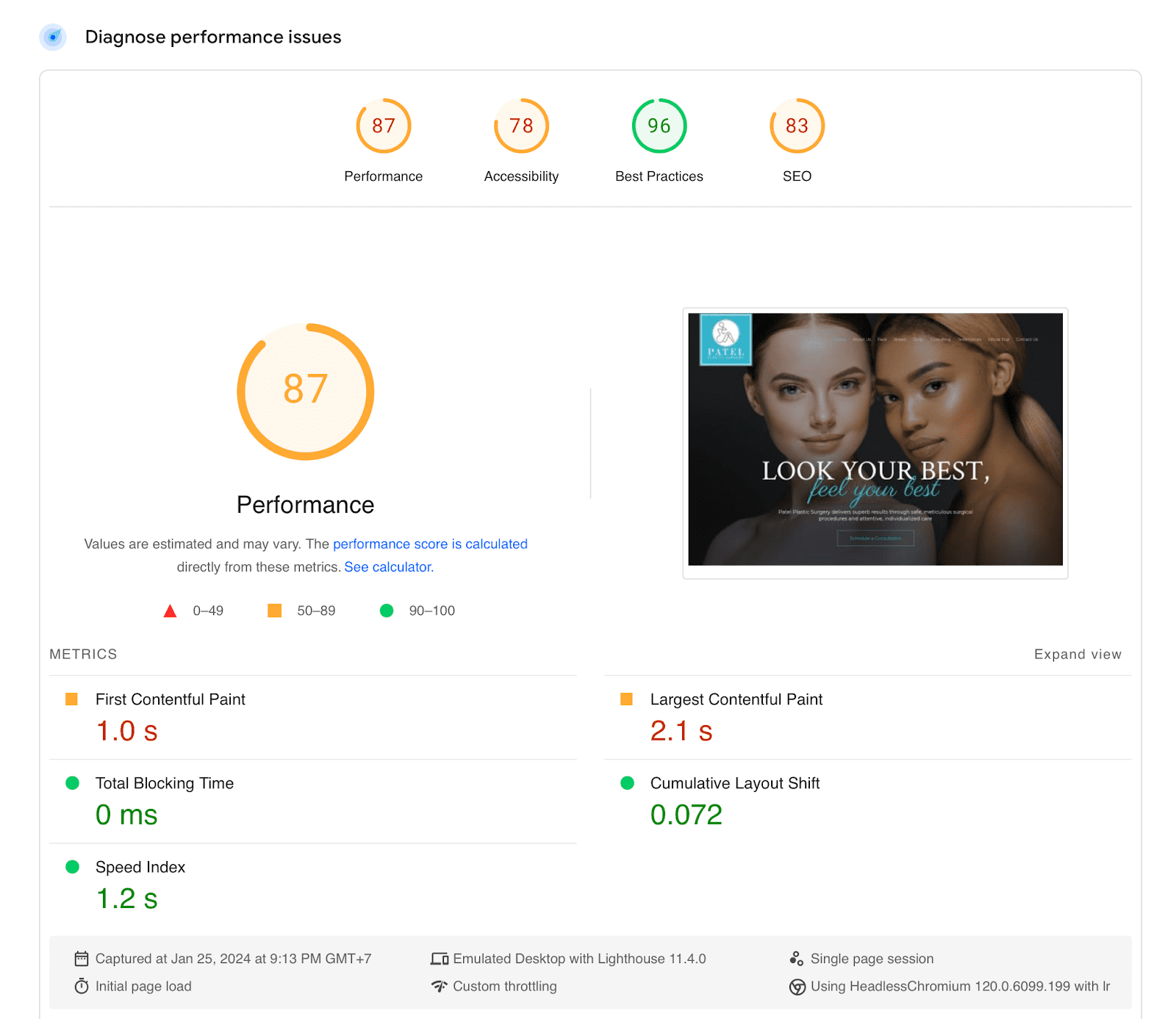
Page load speed is a critical factor for both search engine rankings and user experience. Optimize your website’s loading time by compressing images, minimizing code, and using caching.
Use tools like Google PageSpeed Insights to identify areas for improvement.
Speed Optimization Service: If you need help improving your page load speeds, our website experts can help you get it done.
Mobile Optimization
Mobile optimization ensures that visitors accessing your site from smartphones and tablets have a seamless and user-friendly experience. Here’s how to understand, test, and implement mobile optimization for your business website:
Understanding Mobile Optimization
What It Means: Mobile optimization involves designing your website so that it looks and functions well on mobile devices. This includes readable text without zooming, adequately sized and spaced touch elements (like buttons), and fast loading times.
Why It’s Important: With Google’s mobile-first indexing, your site’s mobile version is the primary one used for indexing and ranking. A mobile-optimized site can lead to better search engine rankings, improved user experience, and higher conversion rates.
Testing for Mobile Optimization:
Bing’s Mobile-Friendly Test
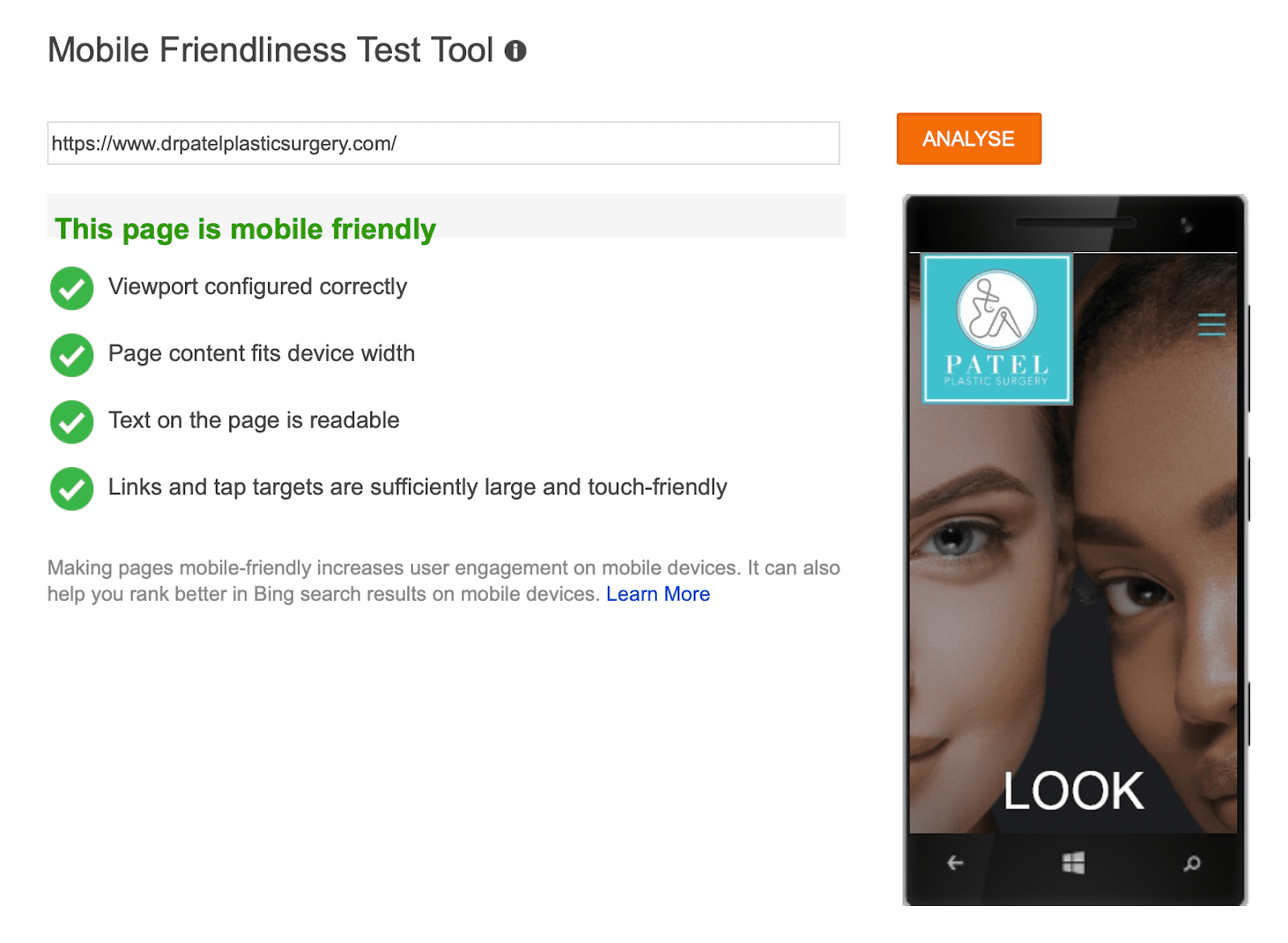
Use Bing’s Mobile-Friendly Test tool to check how well your site performs on mobile devices. Simply enter your website’s URL, and the tool will analyze its mobile-friendliness and highlight any issues.
Manual Testing
Manually test your website on various devices and browsers. Pay attention to the ease of navigation, the readability of content, and the functionality of interactive elements.
Ask friends or colleagues to test your site on their devices and provide feedback.
Optimizing Your Website for Mobile Devices
Responsive Design
Implement a responsive web design that automatically adjusts the layout and content based on the screen size of the device being used.
Responsive design eliminates the need for a separate mobile site and ensures a consistent user experience across all devices.
Simplify Design and Content
Simplify your website’s design for mobile users. Avoid large images or complex graphics that can slow down loading times.
Ensure that content is concise and to the point, making it easier for mobile users to find the information they need quickly.
Touch-Friendly Navigation
Design your site with touch navigation in mind. Buttons and links should be easy to tap, and forms should be simple to fill out on a mobile device.
Consider the size and spacing of touch elements to prevent accidental clicks.
Local Business Schema
Schema markup, particularly for local businesses, is a powerful SEO tool that helps search engines understand the context of your content and enhances your visibility in local search results. Implementing local business schema on your website can significantly boost your local SEO efforts. Here’s what you need to know:
Understanding Local Business Schema
What It Is: Schema markup is a type of structured data that you add to your website’s HTML. It helps search engines understand specific details about your business, such as your address, phone number, business hours, and more.
Why It’s Important: For local businesses, schema markup can improve how your business appears in search results, potentially showing rich snippets like a map to your location, your star ratings from reviews, or your business hours. This enhanced visibility can attract more clicks and drive traffic to your site.
Implementing Local Business Schema
Identify Relevant Schema Types
Depending on your business type, identify the most relevant schema categories. Common types for local businesses include ‘LocalBusiness’, ‘Organization’, ‘Place’, and specific categories like ‘Restaurant’ or ‘Store’.
You can find a full list of schema types on Schema.org.
Use Schema Markup Tools
Tools like Google’s Structured Data Markup Helper can simplify the process of creating schema markup. Select the type of data (e.g., a local business), paste the URL of the page you want to markup, and use the tool to tag different elements on your page.
Once you’ve tagged elements like your address and business hours, the tool will generate the HTML code with the appropriate schema markup.
Add Schema to Your Website
Add the generated schema markup to your website’s HTML. This is typically done in the header or footer of your website, or on specific pages like your contact page.
If you’re not comfortable editing HTML, consider asking your web developer or using a CMS (i.e. WordPress) plugin that simplifies schema implementation.
Test Your Schema Implementation
After adding schema markup to your site, use Google’s Rich Results Test tool to ensure it’s implemented correctly. This tool will show you how your page might appear in search results and highlight any errors in your markup.
Regularly testing and updating your schema is important, especially if there are changes to your business information.
Monitor Performance and Adjust as Needed
Keep an eye on your website’s performance in search results after implementing schema markup. Tools like Google Search Console can provide insights into how your rich snippets are performing.
Be prepared to adjust your schema as needed, especially if you expand your services or change business details.
Reputation Management in Local SEO
Effective reputation management is a cornerstone of local SEO, as it directly influences how your business is perceived online. Building upon our earlier discussions on reviews and online presence, let’s delve deeper into advanced strategies for managing and enhancing your business’s reputation in the local digital landscape.
Advanced Review Management Techniques
Beyond simply responding to reviews, as mentioned earlier, develop strategies to regularly solicit feedback from customers. This could involve follow-up emails or SMS post-service, incentivizing reviews without violating platform policies.
Analyze review patterns to identify areas for improvement in your services or customer experience.
Crafting a Positive Online Narrative
Utilize your website and social media to tell your business’s story. Share customer success stories, behind-the-scenes glimpses, and community involvement.
Regularly update your content to reflect current initiatives, achievements, and customer testimonials, reinforcing a positive image.
Proactive Engagement on Social Media
As an extension of the social media strategies discussed previously, focus on building a community around your brand. Engage in local discussions, support other local businesses, and participate in or host community events, sharing these experiences online.
Monitor social media mentions and engage in conversations where your business is mentioned, showing that you’re actively involved and attentive to customer feedback.
Handling Negative Feedback Strategically
Also in line with our earlier discussion on managing online reviews, develop a comprehensive approach to address negative feedback. This might include internal reviews of service protocols, staff training, or customer service enhancements.
Consider creating a dedicated section on your website for FAQs or customer service assurances based on common feedback themes.
Utilizing Local Media and PR
Engage with local media outlets for features, interviews, or expert opinions. This not only builds your reputation but also contributes to your local SEO through valuable backlinks, as highlighted in the “Local Link Building” section above.
Develop press releases or news updates about significant milestones or community initiatives your business is involved in.
Continuous Monitoring and Adaptation
Use tools like Google Alerts, social media monitoring software, and review site notifications to stay on top of your online reputation.
Regularly assess your reputation management strategies and adapt them based on new trends, customer feedback, and changes in the local market.
Learn more 👇
Measuring and Adapting Your Local SEO Efforts
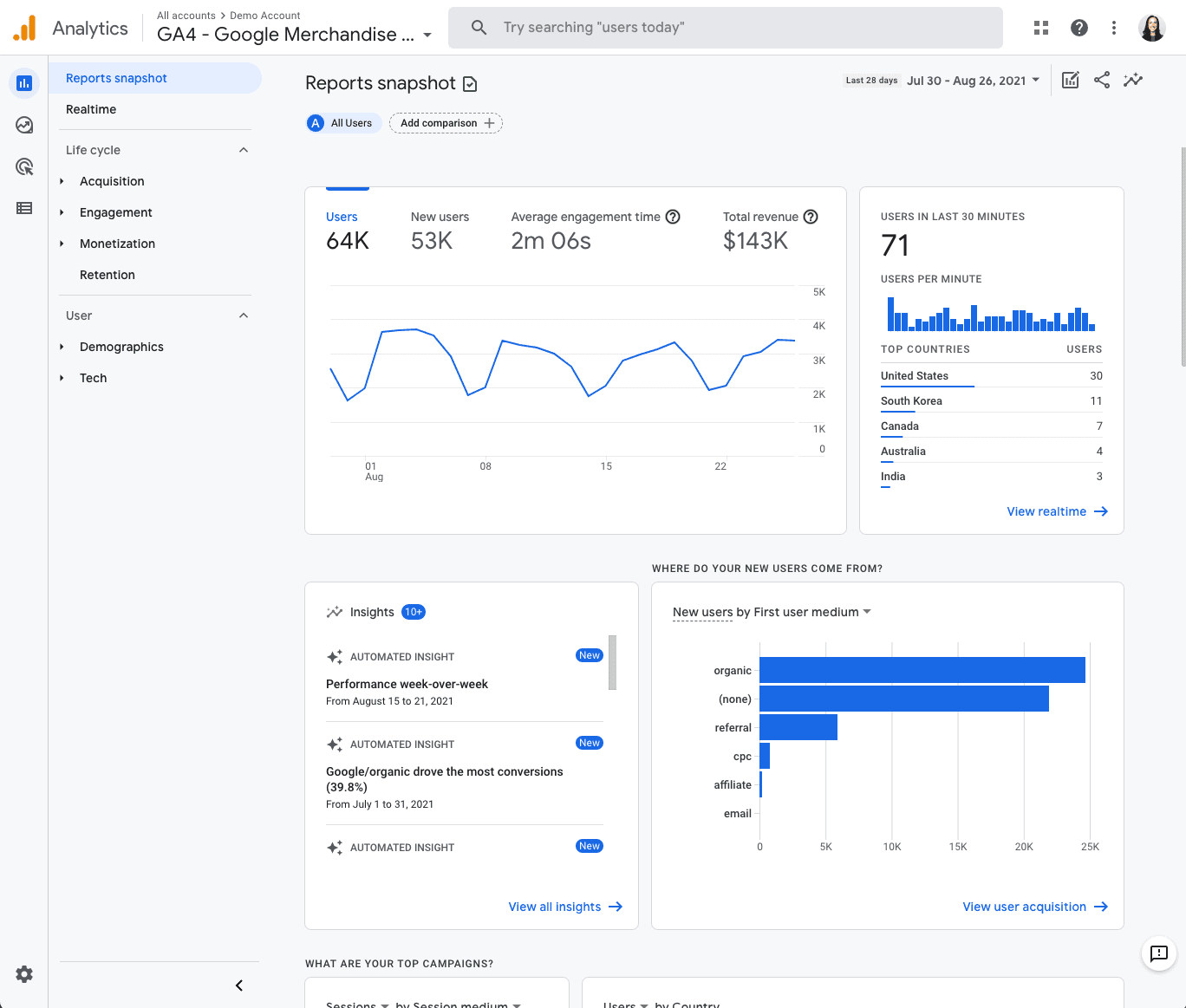
Effective local SEO is not a set-it-and-forget-it strategy – you probably know that by now. Like all good well-oiled machines, it requires ongoing measurement and maintenance to ensure that your efforts are yielding the desired results and to keep up with the latest competition and algorithm updates. Here’s how you can measure and adapt your local SEO strategies effectively:
Tracking Key Performance Indicators (KPIs)
Identify the KPIs that are most relevant to your local SEO goals. These might include local search rankings, website traffic from local searches, click-through rates from Google My Business listings, and the number of reviews or average rating on local directories.
Use tools like Google Analytics to track website traffic and user behavior, and Google Search Console for insights into search rankings and visibility.
Learn more 👇
Utilizing Google My Business Insights
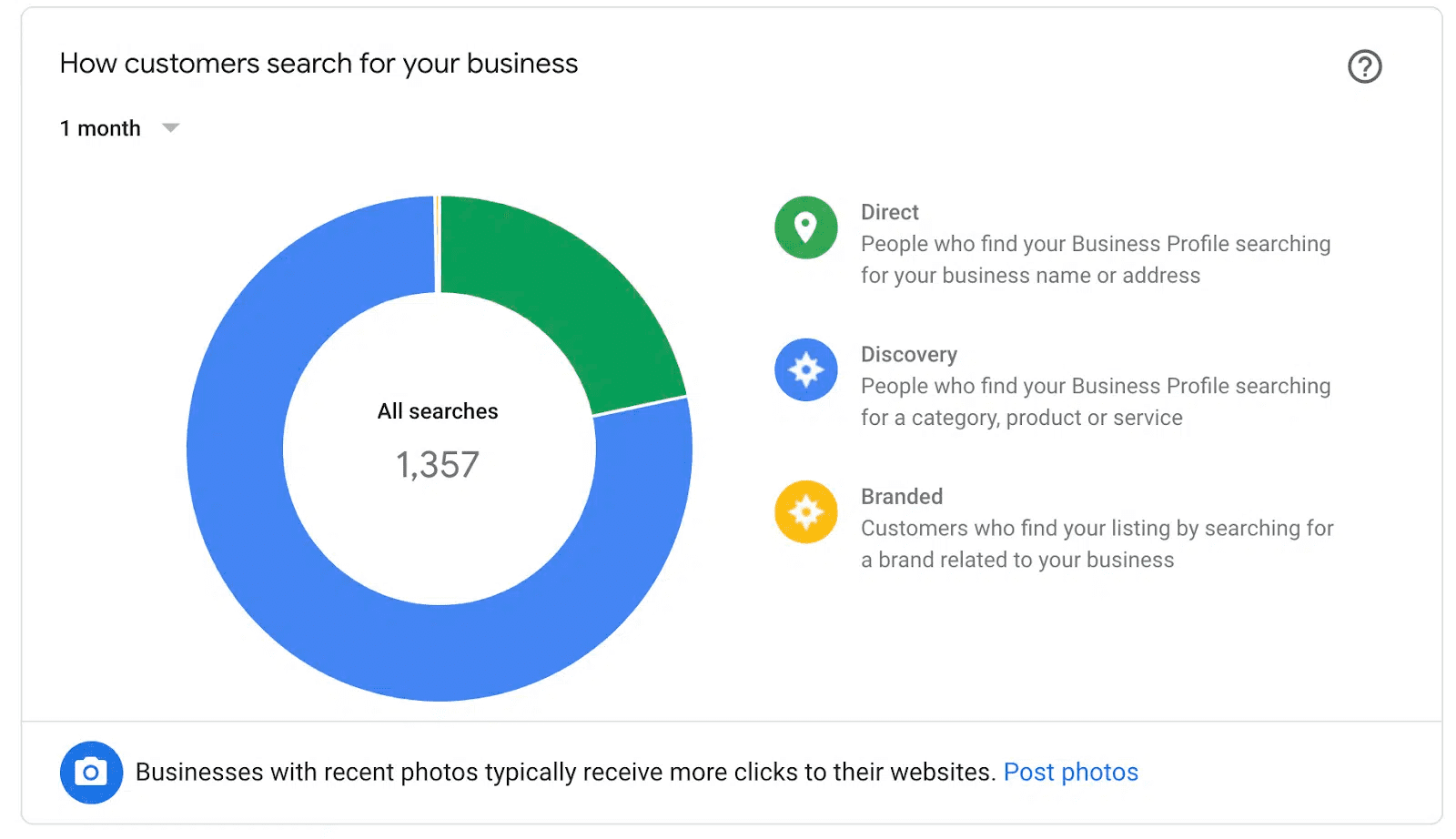
Regularly review the analytics provided by Google My Business. This includes data on how customers are finding your listing (direct vs. discovery searches), actions taken on your listing (like calls or website visits), and where customers are located.
This information can help you understand the effectiveness of your GMB optimization efforts, as discussed in previous sections.
Monitoring Local Search Rankings
Keep track of your rankings for key local search terms. BrightLocal can provide detailed insights into your local search performance.
Pay attention to fluctuations in rankings and investigate potential causes, such as algorithm updates or increased competition.
Analyzing Customer Reviews and Feedback
Regularly assess the feedback you receive in online reviews. Look for common themes or areas for improvement that can inform your business strategies.
As mentioned in the “Reputation Management” section, use reviews as a tool for both reputation enhancement and customer experience improvement.
Adapting Based on Insights
Use the data and insights gathered to make informed decisions about your local SEO strategies. This might involve refining your keyword focus, enhancing your content strategy, or improving your customer service based on review feedback.
Stay adaptable and be prepared to pivot your strategies in response to new trends, customer behaviors, or changes in the local market.
Staying Informed on Local SEO Trends
Keep yourself updated on the latest local SEO trends and best practices. This includes staying informed about Google algorithm updates, new features in local search, and evolving customer search behaviors.
Regularly educate yourself through reputable SEO blogs, webinars, and industry forums.
Local SEO in Action: Success Stories
To truly understand the impact of local SEO, it’s invaluable to see it in action. Here, we showcase two real-life success stories that highlight the transformative power of effective local SEO strategies.
Dynamic Solutions Group: A Leap in Organic Traffic and Leads
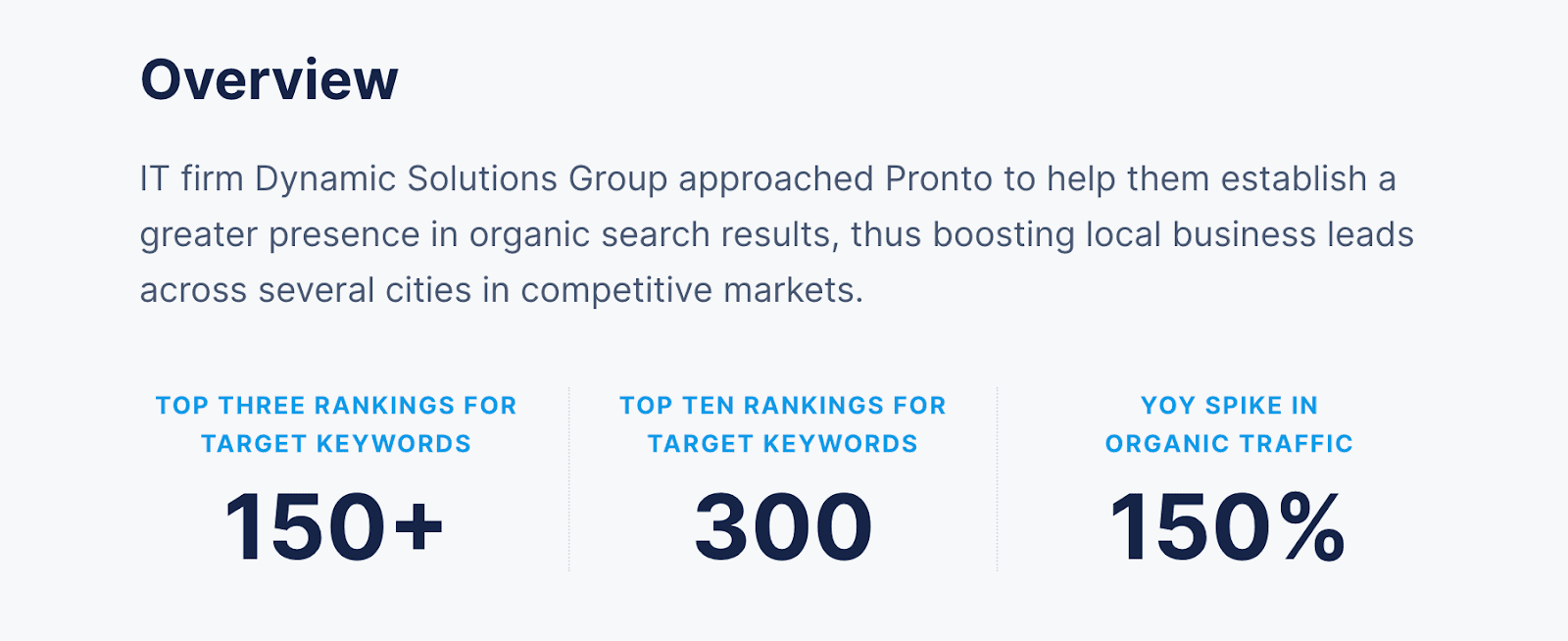
Dynamic Solutions Group, an IT firm based in Palm Harbor, Florida, faced challenges in gaining local leads and visibility in search results. Their journey with local SEO, as detailed in our case study, showcases a remarkable transformation:
The Challenge: Initially, Dynamic Solutions Group struggled with an underwhelming presence in Google search results, leading to insufficient local leads.
Strategic SEO Implementation: By creating targeted service area pages, optimizing their Google My Business listing, and launching a backlink campaign, they addressed key local SEO elements.
Impressive Results: The results were striking. They achieved top three rankings for target keywords, a year-over-year spike in organic traffic, and a significant increase in leads.
This case exemplifies how a multi-faceted local SEO strategy can lead to substantial improvements in both online visibility and business growth.
Read full case study 📈
Fresh Fit 405: Transforming GMB Profile for Explosive Local Lead Growth
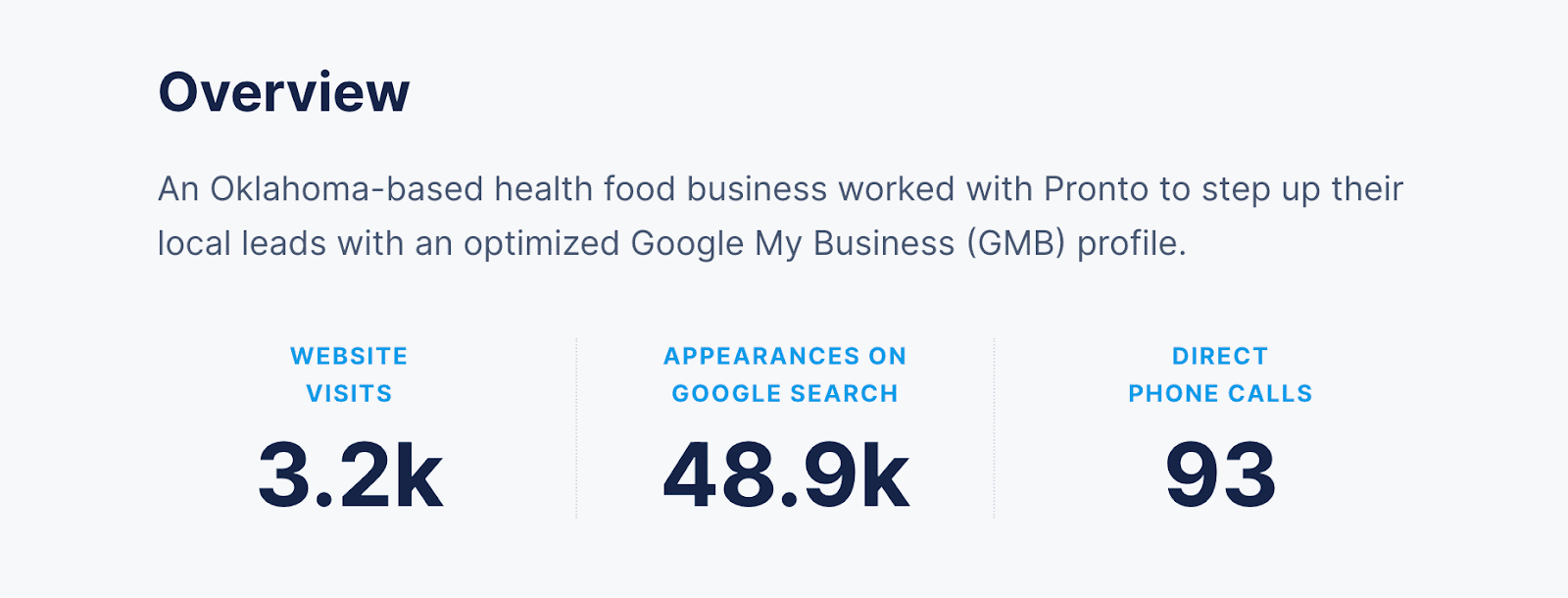
Fresh Fit 405, a health food business in Oklahoma City, showcases the remarkable impact of a well-optimized Google My Business (GMB) profile. Their journey, detailed in our case study, is a testament to the power of strategic GMB management:
The Challenge: Initially, Fresh Fit 405’s GMB profile was underutilized, with minimal interaction and stagnant lead generation results, despite being a popular word-of-mouth business.
Strategic GMB Overhaul: The Pronto team conducted a comprehensive GMB profile audit, identifying key areas for improvement. This included adding target keywords, optimizing profile information, building citations, and implementing a consistent content update strategy.
Impressive Outcomes: The results were immediate and sustained. Fresh Fit 405 experienced a 2139% increase in site visits, a 1867% rise in direct inquiries, and a staggering 4550% boost in direct phone calls. Their GMB profile became a significant driver for local leads, with over 68,000 appearances on Google Maps and Search over ten months.
Fresh Fit 405’s success story underscores the transformative potential of effectively managed Google My Business profiles in driving local engagement and lead generation.
Read full case study 📈
Final Takeaways
As we wrap up this comprehensive guide on local SEO for small businesses, it’s important to reflect on the journey we’ve taken and the valuable insights we’ve gathered.
The Power of Local SEO
We’ve explored how local SEO can transform your business, from increasing your visibility in local search results to attracting more foot traffic and building a robust online reputation. Remember, whether you’re optimizing your Google My Business listing, engaging in local link building, or managing online reviews, each step contributes significantly to your overall local SEO success.
The Importance of Adaptation and Learning
One key takeaway is the importance of continuous learning and adaptation. The digital landscape is ever-evolving, and staying informed and adaptable is crucial. Regularly measure your SEO efforts, as discussed in the “Measuring and Adapting Your Local SEO Efforts” section, and be ready to refine your strategies in response to new trends and customer feedback.
Building a Strong Local Presence
The journey to optimizing your local SEO will be ongoing. It’s about building and maintaining a strong presence in your community, both online and offline. Engage with your local audience, participate in community events, and showcase your local involvement. This not only strengthens your SEO efforts but also deepens your connection with your community.
Seeking Professional Assistance
While this guide provides a solid foundation, navigating the intricacies of local SEO can sometimes be challenging. Don’t hesitate to seek professional assistance if you need help crafting or implementing your local SEO strategy.
Your Path to Local SEO Success
Finally, remember that every step you take towards optimizing your local SEO is a step towards growing your business. With dedication, patience, and the right strategies, you can enhance your online presence, attract more customers, and achieve your business goals.
As you continue on your local search engine optimization journey, keep these final thoughts in mind. The effort you put in today can lead to significant rewards for your business tomorrow.
Tools Index for Local SEO
Purpose: Keyword research, backlink analysis, and tracking SEO performance.
Application: Useful for identifying keyword opportunities, analyzing backlinks, and monitoring local SEO progress.
Purpose: Local SEO audit and citation tracking.
Application: Provides insights into local search rankings and the effectiveness of citation strategies.
Purpose: Testing website mobile optimization.
Application: Assesses how well a website performs on mobile devices and identifies areas for improvement on Bing.
Purpose: Analyzing website loading speed.
Application: Offers recommendations to improve website speed, crucial for both mobile and desktop SEO.
Purpose: Providing a collection of shared vocabularies webmasters can use to markup their pages in ways that can be understood by major search engines.
Application: A resource for understanding and implementing schema markup, enhancing the way search engines read and represent your page in SERPs.
Purpose: Creating schema markup for web pages.
Application: Assists in adding structured data to enhance how pages appear in search results.
Purpose: Testing the effectiveness of structured data.
Application: Verifies that schema markup on a website is correctly implemented and displays potential rich results.
Purpose: Tracking website traffic and user behavior.
Application: Provides insights into how users interact with your website, which is crucial for understanding the impact of your local SEO efforts.
Purpose: Monitoring website performance in Google search results.
Application: Offers data on search rankings, website impressions, clicks, and technical issues, helping to refine your SEO strategy.
Purpose: Monitoring online mentions of your business.
Application: Keeps track of where and how your business is mentioned online, aiding in reputation management.




